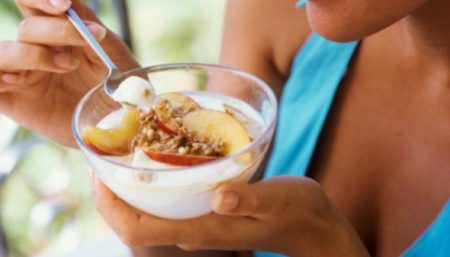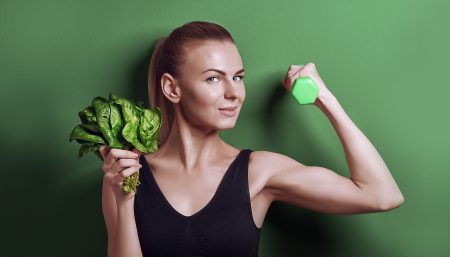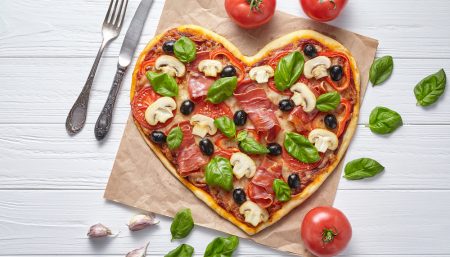
Protein is needed to help the body build strong muscles, repair tissues and maintain an effective immune and hormonal system. If you have a physically active job or are involved in rigorous sports training, you may need more protein in your daily diet. Excellent sources of protein are meat, poultry, fish, eggs and dairy products followed by soya products, pulses, grains, nuts seeds, vegetable and fruits.
When one decides not to eat fish, poultry or meat, it becomes slightly more difficult to make sure that your body receives enough protein everyday. Still a variety of menu-planning approaches can provide vegetarians with adequate nutrition.
Depending on the amount of animal products consumed, vegetarians can be broadly classified into 3 groups:
Lacto-Ovo-Vegetarians: no red meat, chicken nor fish, but the consumption of dairy products and eggs. The variation of vegetarianism that most often calls itself simply “vegetarian”.
Lacto-Vegetarians: no meat and no eggs, save the consumption of milk.
Vegans: no meat, eggs nor milk. No animal products of any kind. Vegans also try to avoid wearing wool and leather.
Following guidelines below can help vegetarians plan healthful diets.
- Choose a variety of foods, including whole grains, vegetables, fruits, legumes, nuts, seeds and, if desired, dairy products and eggs.
- Choose whole, unrefined foods often and minimize intake of highly sweetened, fatty, and heavily refined foods.
- Choose a variety of fruits and vegetables. (Click here to check out the number of serving of various foods in a vegetarian diet)
- If animal foods such as dairy products and eggs are used, choose lower-fat versions of these foods. Cheeses and other high-fat dairy foods and eggs should be limited in the diet because of their saturated fat content and because their frequent use displaces plant foods in some vegetarian diets.
- Vegans should include a regular source of vitamin B-12 in their diets along with a source of vitamin D if sun exposure is limited.
Eating a good quantity and variety of following foods everyday should help you in meeting the daily protein requirement:
1. Legumes- also called dried beans, are edible seeds that grow in pods. There are more than 13,000 varieties of legumes growing in the world, but only about 40 types are commonly consumed. Because they are an inexpensive, easily grown source of protein, they have been central to diets around the world for 12,000 years. Introducing legumes into menus offers a chance to explore different ethnic cuisines. Use legumes as main dish items rather than side dishes. A good way to introduce beans to the diet is to decrease meat in favourite dishes, like casseroles and chili, and replace it with beans. Because of their many health benefits, beans should be eaten often. Example are chickpeas, split peas, haricot, lentils (red, green or brown), kidney beans, flagelot etc.
2. Nuts & seeds-Nuts are fruits that have a hard outer shell that encloses a kernel, which is also called a nut. Seeds are contained in fruits of plants and are capable of reproducing a new plant. An important source of nutrition for thousands of years the world over, nuts and seeds are still staple foods and an important protein source in many cultures. Many nuts and seeds are available both in and out of the shell, whole, halved, sliced, chopped, raw, or roasted example are cashew, peanuts, walnuts, almonds.

3. Dairy products-Dairy foods are products made from milk, the liquid secreted by female mammals for suckling their young. Choose nonfat or low-fat milk, yogurt and cheese for daily consumption. Save high-fat cheeses and ice cream for occasional treats. Experiment with lower fat cheeses to find products you enjoy. Options include soft uncured cheeses such as hoop cheese, lower fat (dry curd) cottage cheese, kwark (quark), and nonfat ricotta, all of which meet the U.S. dietary goal of 30% calories from fat. Read the fine print to learn the actual level of saturated fat in dairy products. Be aware that “light” or “part-skim” cheese often derives up to 65% of its calories from fat. Look for products with few or no additives and preservatives. For example, heavy whipping cream often contains added emulsifiers and stabilizers, though versions with neither are available. Consider choosing yogurts with few or no additives and adding your own fresh or dried fruit to plain yogurt rather than opting for highly sweetened varieties. To increase calcium and protein content, add powdered milk when baking quick breads or casseroles.
4. Cereals & food grains-Grains are the seeds or fruit of cereal plants, used as food by humans and animals. Choose whole grain flours, cereals, wheat & rye breads, buckwheat pancakes, muffins & scones, noodles and pasta. Check the nutritional facts panel on the label for fat, sugar, and additives. Eat grain with complementary protein. Experiment with high quality grains, such as amaranth and quinoa.
5. Algae-Blue-green algae, of which spirulina is a well-known example, is a group of 1,500 species of microscopic aquatic plants. The two most common species used for human consumption are Spirulina maxima and Spirulina platensis. Spirulina is particularly rich in protein and also contains carotenoids, vitamins, minerals, and essential fatty acids, one though its vitamin B12 content does not appear to be readily usable by people and second most health benefits to humans claimed for spirulina and other blue-green algae supplementation come from anecdotes and not scientific research.

6. Soyabean-A versatile bean use extensively in cooking, the soybean also serves as the basis for a wide variety of soya foods consumed. Soybeans are the richest plant source of high-quality protein.
Soya protein can help to conserve calcium in the body and enhance bone health when it replaces animal protein in the diet. Soya protein also helps to lower blood cholesterol in people who have high blood cholesterol levels. Adding about 25 grams of soya protein to the diet (the amount in about three servings of soya foods) every day can reduce LDL (the “bad” cholesterol) by as much as 10%. Soya protein is processed more easily by the kidneys and may be useful for people who are at risk for kidney disease when it replaces animal protein in the diet. Besides, soybeans are high in fibre and B-vitamins, particularly folate. Soybeans are high in iron but this mineral is absorbed well only from fermented soya foods like tempeh. The most common soya form is still tofu, but today, the soybean takes on many other forms, including burgers, dogs, bacon, sausage, and many other meat substitutes.
7. Seitan- has been used in Asia as a protein source and meat substitute for hundreds of years. Seitan can be prepared from scratch using whole-wheat flour. The flour is mixed with enough water to make into a dough that is then kneaded in water and rinsed to remove the starch and the bran. The protein, or gluten, remains and is then simmered in a broth flavored with soya sauce to become seitan. The longer the gluten simmers, the firmer it becomes. Seitan can then be sliced for sautés or stir-fries, diced into stews, soups, or casseroles, or formed into roasts. People who are allergic to wheat or wheat gluten should avoid seitan. Do not use if you are gluten-sensitive. A good source of protein delivering 23g/30 gms of Seitan.
8. Vegetable– are loaded with vitamins and minerals essential for varied body processes and have been shown to . provide protection against a variety of illnesses e.g. Quorn, peas, corn, half cooked broccoli, Collard greens, Kale Mustard greens, Turnip greens. When buying vegetables, choose those that are firm and bright, with a fresh, light scent. Don’t buy older vegetables, those that are dried out, shriveled, moldy, cracked, or with an overly strong aroma. Both taste and nutrient value will be compromised. Vegetarians have lower blood pressure than do people who eat meat. This occurs partly because fruits and vegetables contain potassium—a known blood pressure-lowering mineral. Textured vegetable protein is also a good substitute for ground beef in dishes such as tacos, chilli, and stews.

9. Fruits-Plant sources of protein alone can provide adequate amounts of essential amino acids if a variety of plant foods are consumed and energy needs are met. A diet high in fruits appears protective against heart disease. Fruits are often the most nutritious part of the plant and, unlike vegetables, their high water content allows most to be eaten without cooking. Because they are usually sweet, fruits are often eaten as a dessert, for breakfast, or as a refreshing snack e.g. dried figs. Most fruits can be stored well, canned, frozen, or dried, and today’s transportation and refrigeration allow us to enjoy a wide variety of fresh fruit year-round.
10. Egg– Brown or white? Either and both is a source of complete protein. The colour of the egg’s shell is simply an indicator of the breed of hen that laid the egg. Eggs yolks are among the few foods that contain vitamin D. Eggs are the centerpiece of a range of foods. Many egg dishes, such as omelets and frittatas, can be prepared quickly with many interesting fillings, such as peppers, tomatoes, or zucchini.
Although vegetarian diets are lower in total protein and a vegetarian’s protein needs may be somewhat elevated because of the lower quality of some plant proteins, protein intake in both lacto-ovo-vegetarians and vegans can be made adequate by careful planning and smart cooking. To calculate your daily protein intake, click here.
Disclaimer
The Content is not intended to be a substitute for professional medical advice, diagnosis, or treatment. Always seek the advice of your physician or other qualified health provider with any questions you may have regarding a medical condition.



